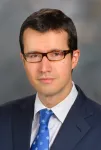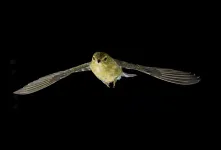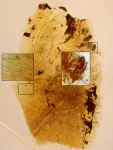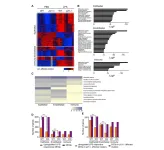No magic number for time it takes to form habits
New machine learning study finds different habits take varying amounts of time to take root
2023-04-17
(Press-News.org)
Putting on your workout clothes and getting to the gym can feel like a slog at first. Eventually, you might get in the habit of going to the gym and readily pop over to your Zumba class or for a run on the treadmill. A new study from social scientists at Caltech now shows how long it takes to form the gym habit: an average of about six months.
The same study also looked at how long it takes health care workers to get in the habit of washing their hands: an average of a few weeks.
“There is no magic number for habit formation,” says Anastasia Buyalskaya (PhD ’21), now an assistant professor of marketing at HEC Paris. Other authors of the study, which appears in the journal Proceedings of the National Academy of Sciences, include Caltech’s Colin Camerer, Robert Kirby Professor of Behavioral Economics and director and leadership chair of the T&C Chen Center for Social and Decision Neuroscience, and researchers from the University of Chicago and the University of Pennsylvania. Xiaomin Li (MS ’17, PhD ’21), formerly a graduate student and postdoctoral scholar at Caltech, is also an author.
“You may have heard that it takes about 21 days to form a habit, but that estimate was not based on any science,” Camerer says. “Our works supports the idea that the speed of habit formation differs according to the behavior in question and a variety of other factors.”
The study is the first to use machine learning tools to study habit formation. The researchers employed machine learning to analyze large data sets of tens of thousands of people who were either swiping their badges to enter their gym or washing their hands during hospital shifts. For the gym research, the researchers partnered with 24 Hour Fitness, and for the hand-washing research, they partnered with a company that used radio frequency identification (RFID) technology to monitor hand-washing in hospitals. The data sets tracked more than 30,000 gymgoers over four years and more than 3,000 hospital workers over nearly 100 shifts.
“With machine learning, we can observe hundreds of context variables that may be predictive of behavioral execution,” explains Buyalskaya. “You don’t necessarily have to start with a hypothesis about a specific variable, as the machine learning does the work for us to find the relevant ones.”
Machine learning also let the researchers study people over time in their natural environments; most previous studies were limited to participants filling out surveys.
The study found that certain variables had no effect on gym habit formation, such as time of day. Other factors, such as one’s past behavior, did come into play. For instance, for 76 percent of gymgoers, the amount of time that had passed since a previous gym visit was an important predicator of whether the person would go again. In other words, the longer it had been since a gymgoer last went to the gym, the less likely they were to make a habit of it. Sixty-nine percent of the gymgoers were more likely to go to the gym on the same days of the week, with Monday and Tuesday being the most well attended.
For the hand-washing part of the study, the researchers looked at data from health care workers who were given new requirements to wear RFID badges that recorded their hand-washing activity. “It is possible that some health workers already had the habit prior to us observing them, however we treat the introduction of the RFID technology as a ‘shock’ and assume that they may need to rebuild their habit from the moment they use the technology,” Buyalskaya says.
“Overall, we are seeing that machine learning is a powerful tool to study human habits outside the lab,” Buyalskayasays.
The study titled “What can machine learning teach us about habit formation? Evidence from exercise and hygiene” was funded by the Behavior Change for Good Initiative, the Ronald and Maxine Linde Institute of Economics and Management Sciences at Caltech, and the Tianqiao and Chrissy Chen Institute for Neuroscience at Caltech.
END
ELSE PRESS RELEASES FROM THIS DATE:
2023-04-17
Cai from Argonne’s X-ray Science division recognized for his commitment and advances in beamline science, most notably X-ray diffraction.
Physicist Zhonghou Cai is the 2023 recipient of the Gopal K. Shenoy Excellence in Beamline Science Award. He is a beamline scientist at the U.S. Department of Energy’s (DOE) Argonne National Laboratory.
The annual award recognizes active beamline scientists at the Advanced Photon Source (APS), a DOE Office of Science user facility, for significant contributions to research or instrumentation and support of the beamline user community. The APS Users Office, which grants the award, renamed it ...
2023-04-17
ABSTRACT: 3431
ORLANDO, Fla. ― A new study led by researchers at The University of Texas MD Anderson Cancer Center discovered that co-occurring mutations in three tumor suppressor genes – KEAP1, SMARCA4 and CDKN2A – are linked with poor clinical outcomes in patients with KRAS G12C-mutant non-small cell lung cancer (NSCLC) treated with the KRAS G12C inhibitors adagrasib or sotorasib.
The findings were presented today at the American Association for Cancer Research (AACR) Annual Meeting 2023 and published in Cancer Discovery, a journal of the AACR. This study, which encompasses the largest cohort to date of patients with KRAS G12C-mutant NSCLC treated with ...
2023-04-17
New York, NY (April 17, 2023) — Tisch Cancer Center scientists have developed unique models of the deadliest blood cancer, acute myeloid leukemia (AML), creating a transformative resource to study this cancer and eventually its drug response and drug resistance. The models were described in a late-breaking abstract at the annual meeting of the American Association of Cancer Research and simultaneously published in Blood Cancer Discovery, a journal of the American Association for Cancer Research.
These are the first powerful models that are ...
2023-04-17
When a person reads a sentence, two distinct networks in the brain are activated, working together to integrate the meanings of the individual words to obtain more complex, higher-order meaning, according to a study at UTHealth Houston.
The study, led by Oscar Woolnough, PhD, postdoctoral research fellow in the Vivian L. Smith Department of Neurosurgery with McGovern Medical School at UTHealth Houston, and Nitin Tandon, MD, professor and chair ad interim of the department in the medical school, was published ...
2023-04-17
AMHERST, Mass. – A team of scientists led by researchers at the University of Massachusetts Amherst has recently made a surprising discovery, with the help of a wind tunnel and a flock of birds. Songbirds, many of which make twice-yearly, non-stop flights of more than 1,000 miles to get from breeding range to wintering range, fuel themselves by burning lots of fat and a surprising amount of the protein making up lean body mass, including muscle, early in the flight. This flips the conventional wisdom ...
2023-04-17
New fossils in amber have revealed that beetles fed on the feathers of dinosaurs about 105 million years ago, showing a symbiotic relationship of one-sided or mutual benefit, according to an article published in Proceedings of the National Academy of Sciences of the United States of America today*.
The main amber fragments studied, from the Spanish locality of San Just (Teruel), contain larval moults of small beetle larvae tightly surrounded by portions of downy feathers. The feathers belonged to an unknown theropod dinosaur, either avian (a term referring ...
2023-04-17
Vikings occupied Greenland from roughly 985 to 1450, farming and building communities before abandoning their settlements and mysteriously vanishing. Why they disappeared has long been a puzzle, but a new paper from the Department of Earth and Planetary Sciences (EPS) determines that one factor – rising sea level – likely played a major role.
“There are many theories as to what exactly happened” to drive the Vikings from their settlements in Greenland, said Marisa J. Borreggine, lead author of the “Sea-Level ...
2023-04-17
Results from the S1609 DART clinical trial, which tested an immunotherapy combination of ipilimumab plus nivolumab in 53 cohorts of patients with rare cancers, are being reported for five cohorts of patients who had rare gynecologic cancers.
In three of those five cohorts – the cohorts for clear cell ovarian cancer; small cell ovarian carcinoma, hypercalcemic type; and non-epithelial ovarian cancer – some patients have shown durable responses to the immunotherapy, including several patients whose complete remissions have now lasted more than three years.
The findings will be presented in three abstracts at the 2023 ...
2023-04-17
Blind or colorblind people can describe colors and use expressions like “green with envy” or “feeling blue.” A hearing-impaired person can also say those same vibrant hues are “loud.” But many linguists and cognitive neuroscientists have assumed that somatosensation—touch, pain, pressure, temperature, and proprioception, or the sense of where your body is oriented in space—is fundamental for understanding metaphors that have to do with tactile sensations. Understanding expressions like “she is having a tough time” or “that class was hard,” it was believed, requires previous experience with those sensations to extend ...
2023-04-17
“Our results implicate p21 as a critical regulator of chronic bronchitis and a driver of chronic airway inflammation and lung destruction.”
BUFFALO, NY- April 17, 2023 – A new research paper was published on the cover of Aging (listed by MEDLINE/PubMed as "Aging (Albany NY)" and "Aging-US" by Web of Science) Volume 15, Issue 7, entitled, “p21 facilitates chronic lung inflammation via epithelial and endothelial cells.”
Cellular senescence is a stable state of cell cycle arrest that regulates tissue ...
LAST 30 PRESS RELEASES:
[Press-News.org] No magic number for time it takes to form habits
New machine learning study finds different habits take varying amounts of time to take root




